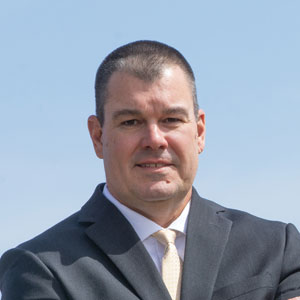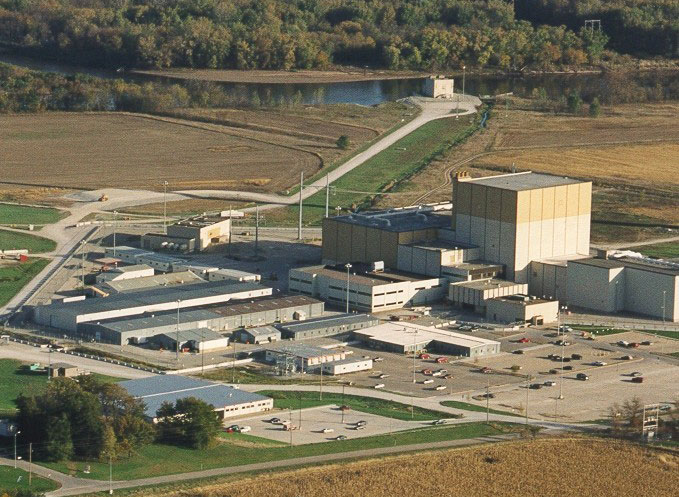Governor’s energy plan targets nuclear, wind, energy storage, new economic development tools

Companion bills proposed by Gov. Kim Reynolds that promote new energy generation, transmission and storage projects, and water infrastructure in Iowa are moving in the state House and Senate.
The legislation makes a host of changes in how energy generation and water projects are regulated and funded in Iowa.
It makes it clear the state wants to promote the exploration of nuclear power through small modular reactors (SMR) as a viable baseload energy source.
“It is also the intent of the general assembly to encourage the development of nuclear electric power generation within the state using nuclear reactors and the use of nuclear power to meet local and regional electrical needs,” House Study Bill 123 says.
The bill creates a tariff for public utility “innovation” programs that allow utilities to form special ratemaking for customers, such as large industrial or data center facilities, to pay for the cost of building new power generation assets they need for business, as well as usage monitoring.
The plan modifies Iowa’s energy infrastructure revolving loan fund to add water projects, allows cities and counties access to the fund for the first time and shifts oversight of the money from the Iowa Energy Center to the Iowa Economic Development Authority.
If approved in its current form, the bills also lower the threshold from 300 megawatts to 40 megawatts for utilities seeking a contested case proceeding by the Iowa Utilities Commission (IUC) to use special ratemaking principles for wind, solar or power storage installations.
Economic leaders hope these changes could have big implications for the state’s economic development and ability to draw large industrial projects and data centers, and convince existing Iowa companies to expand their footprint.
Some environmentalists and landowners have called on lawmakers to reject or make changes to the energy plan, concerned about radioactive waste produced by nuclear fuel, what they see as a reduced emphasis on energy efficiency and the lack of language specifically addressing wetlands, environmentally sensitive areas and nonagricultural land in required reclamation for transmission projects.
As of Feb. 28, HSB123 had passed a House committee 16-6 and is expected to be sent to the Appropriations Committee, making the legislation funnel-proof. The companion Senate Study Bill 1112 was recommended for passage Feb. 13 by a Senate subcommittee.

Chaz Allen, executive director of the Iowa Utility Association, said the governor’s energy plan is a compromise between Iowa’s energy producers and regulators that’s been in the works for five years.
Allen is a former state senator from Jasper County and was mayor of Newton when city leaders courted TPI Composites Inc. in 2008 to locate a wind turbine blade manufacturing facility left empty when Maytag moved its operations out of Iowa.
He was executive director of the Jasper County Economic Development Corp. when Energy Transfer Partners Inc. sought approvals to run the Dakota Access Pipeline through the county to ship North Dakota crude oil to the Gulf Coast and other refineries.
Allen said Iowa’s need for a more diverse energy mix to support the state’s economic development, particularly in the data center and industrial manufacturing spaces, is increasing.
“If you just look at the change from 2018 to today, when [NextEra Energy Inc.] started the phaseout of [the Duane Arnold Energy Center in] Palo, the nuclear power plant, and the need for that plant, and now there’s a possibility of that plant coming back online, that’s the change,” he said.
NextEra and Iowa American Water are associate members of the Iowa Utility Association with its core members MidAmerican Energy, Black Hills Energy, ITC Midwest and Alliant Energy.
“Now you know you’re coming off decades of low to stagnant growth of electricity to now, accelerating growth of electricity because of reshoring, because of data centers, because of all the things going on in the world today,” Allen said.
In addition to other considerations, the bill directs the IUC to consider approving contracts between utilities and customers through the state’s ratemaking principles “if it finds that the contract will promote economic development within the state.”

Duane Arnold Energy Center in Palo, Iowa, ceased producing power in August 2020 following the derecho that swept across Iowa. Submitted photo
A nuclear future?
Reynolds made exploring the possibility of nuclear energy a stated goal in her 2025 Condition of the State address she delivered in January.
“I’ll be bringing together experts to look at issues like permitting, which often takes too long,” she said in her speech. “They’ll also look at workforce challenges because recruiting nuclear engineers doesn’t happen overnight. And they’ll be talking with stakeholders around the state to make sure we have local buy-in.”
Sixty-one percent of MidAmerican’s power generation capacity came from wind in 2023, and the company has reduced its carbon dioxide emissions rate by 69% since 2005, according to the utility’s November 2024 Resource Evaluation Report.
The investor-owned utility is now looking to SMRs to make nuclear power more cost-effective and take advantage of what could be a carbon-free baseload.
MidAmerican’s Preferred Expansion Portfolio shows a SMR nuclear facility planned to come online in 2036 with a 345-megawatt capacity.
PacifiCorp., a Berkshire-Hathaway-owned sister utility of MidAmerican, and TerraPower, a company co-founded by Bill Gates, are building an SMR in Wyoming, according to the Des Moines Register.
“They want to build that one, see how it works, see what it costs. And the more you replicate that across the country, the cheaper it becomes,” Allen said.
The SMR can be paired with a salt storage technology, according to the MidAmerican report. Molten salt has high boiling points and high volumetric heat capacities and can store excess energy to be used in the future to power steam turbines, a Stanford University study from December 2015 shows.
The megawatt reduction from 300 to 40 for advanced ratemaking in the Iowa legislation could make that storage project eligible for advanced ratemaking and innovation tariffs to help the utility recover the costs.
Allen said contacts would likely ensure companies were paying the innovation tariffs on the power they use from the new asset and not energy generated going back on the open grid. The bill includes protections to ensure that the tariffs would not affect base rates for customers in other rate classes.
If the smaller reactors can reduce costs, economic leaders hope they can be used to power large-scale industrial projects and economic development in Iowa and the population growth that comes with it.
MidAmerican also announced in February its plans to build solar installations at approximately six sites through 2027 and 2028 that are expected to generate up to 800 megawatts of power.
The company also wants to build a 465-megawatt, two-turbine natural gas-fired facility in Adair County that would only run during peak hours when wind and solar will not meet the demand.
Iowa Economic Development Authority Director Debi Durham said that Iowa’s decade-old energy plan “does a shoutout to nuclear” power. But she said until commercial-level battery storage is perfected to store excess energy produced by wind and solar, there needs to be an exploration of another reliable baseload energy in addition to the “insurance policy” provided by natural gas.
“Now is the time, though, I think, [for modular nuclear] with all the conversation around the United States want[ing] to basically own AI, and what that means from a utility need,” Durham said. “So obviously, we are very proud of our renewable energy portfolio, right? It’s been a calling card for Iowa for years, but we also need to invest in baseload.”
For large-scale industrial and commercial projects and data centers, the IEDA often relies on its certified sites program. These registered parcels ranging from 65 acres to over 1,650 acres are shovel-ready and can confirm to a developer that the area meets a company’s power needs.
This holds true for companies negotiating with the IEDA in the new Major Economic Growth Attraction (MEGA) program, which offers tax incentives to businesses looking to make $1 billion-plus investments in Iowa.
“No deal that we have brought the utilities [have] said we can’t fulfill,” Durham said.
Earlier this year, NextEra announced it was taking steps to restart the Duane Arnold nuclear plant in Palo by the end of 2028. The site has a 615-megawatt output, according to the Cedar Rapids Gazette.
NextEra currently operates a solar array it installed at Duane Arnold for Alliant Energy’s use.
Alliant, which provides electric and natural gas service in portions of Iowa and Wisconsin, recently worked with the city of Cedar Rapids to secure data center developer and operator QTS to build a $750 million facility at the Big Cedar Industrial Center.

“We are planning for our customers, to ensure we’re ready to manage the rapidly changing energy landscape,” May Farlinger, president of Alliant’s Iowa energy company and vice president of energy delivery, said in an email. “We take pride in operating our system as efficiently as possible. Our investments in new technology will further enhance efficiency and system operations, and Alliant Energy is open to considering all cost-effective resource options, including repowering of nuclear.
“… We understand the critical role that reliable and cost-effective energy plays in economic development, and Big Cedar was specifically created for opportunities like the ones we are seeing come to fruition.”
Opponents of bill express environmental concerns
Opponents of the bill, like the Iowa Chapter of Sierra Club, are concerned about the bill’s reliance on nuclear power.
Pam Mackey-Taylor, director and lobbyist for the Iowa Sierra Club, told the Business Record that the worry stems from the radioactive waste produced by nuclear power, environmental effects that result from mining uranium and the current costs of reactors that could be passed on to ratepayers.
She wants to see a “better defined” integrated rate program in the bill, and she says there is a “real risk” for an increase in rates to affect more people if a company slated to use the new power generation leaves and there is a stranded asset.
Reynolds’ energy plan gives utility companies a right of first refusal for the proposal of new energy transmission projects. Although Mackey-Taylor said the Sierra Club supports the inclusion of mandatory land reclamation for agricultural land once a transmission project is built, she said opponents want to see wetlands and other environmentally sensitive land types added to that language.
The bill also supports the expansion and regulation of anaerobic digester systems, which use manure and other agricultural waste to produce biogas as a fuel source. Some opponents to the measure worry that the increased income from the biogas sale could encourage farmers to increase the size of their cattle herds and enclosures, Mackey-Taylor said.
Mackey-Taylor said she is encouraged that the bill supports the continued rollout of wind, solar and battery storage technologies and encourages the development of hydrogen power.
Editor’s note: This story was updated March 10 to reflect that NextEra Energy and Iowa American Water are associate members of the Iowa Utility Association.

Mike Mendenhall
Mike Mendenhall is associate editor at Business Record. He covers economic development, government policy and law.

![Whispering Willow Wind Farm, Franklin County, Iowa (Alliant Energy)[8]](https://www.businessrecord.com/wp-content/uploads/2025/03/Whispering-Willow-Wind-Farm-Franklin-County-Iowa-Alliant-Energy8.jpg)







